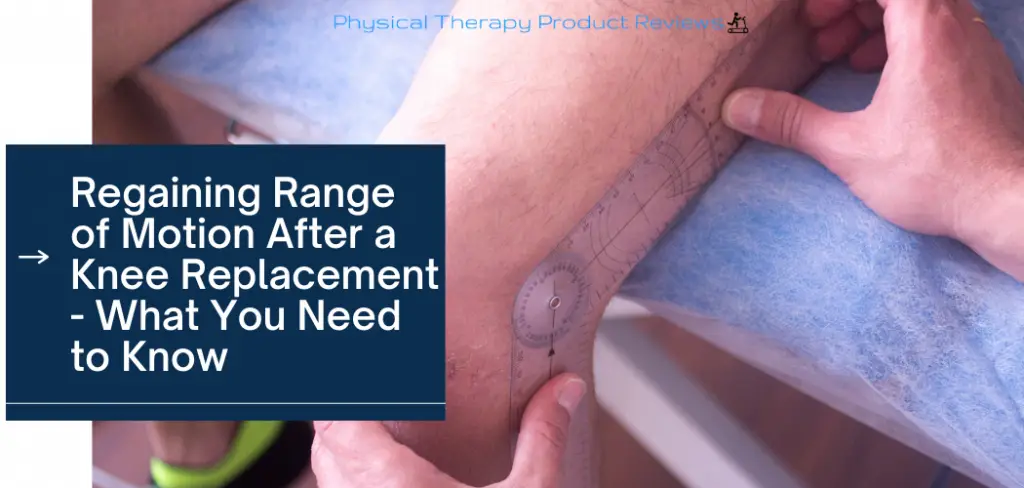After months and months of hobbling around while trying to “suck-it-up,” you finally bit the proverbial bullet and scheduled your total knee replacement surgery. It’s time to get back to doing the things you love without enduring pain with every step you take. Now that you’ve decided to move forward with a total knee replacement, I’m sure you’re wondering how quickly you’ll get your range of motion back so you can return to your regular activities.
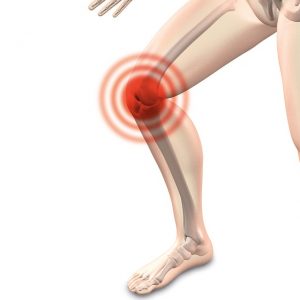
Recovery time depends on many factors, including your age and health at the time of surgery. The healthier and more physically fit you are before you have any surgery plays a great part in how quickly you recover.
If you’re scheduled to have a total knee replacement surgery or just had one, here are some tips on how to regain and maintain your range of motion so you can get back to living your life and focusing on the things that matter most.
Knee Range of Motion Goals and Timeline After a Knee Replacement
| Knee Range of Motion Goals After A Knee Replamcent | ||
|---|---|---|
| Weeks since Surgery | Knee Flexion Goal | Knee Extension Goal |
| End of Week 1 | 65-70° | Less than 5° |
| 2 Weeks | 90° | 0-1° |
| 4 Weeks | 105° or Greater | 0° or full extension |
| 6 Weeks | 115°-120° or Greater | 0° or full extension |
| 12 Weeks | 125° | 0° or full extension |
Have Realistic Expectations Before You Begin
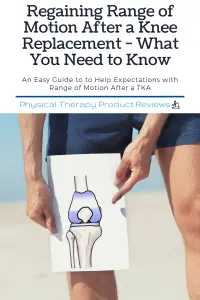 Don’t compare your surgery and recovery to every Tom, Dick, and Harry. Everyone’s experience with a total knee replacement is different. Take your health, age, and activity level into consideration and set your expectations accordingly.
Don’t compare your surgery and recovery to every Tom, Dick, and Harry. Everyone’s experience with a total knee replacement is different. Take your health, age, and activity level into consideration and set your expectations accordingly.
Setting your expectations too high may lead to disappointment. Don’t push yourself too hard. Use other people’s progress as a guide or a goal to work toward, but don’t let it get you down and give up if you are not progressing as quickly as you think you should be.
Progress tends to feel slow for the patient in the first 2-3 weeks and may feel like you are behind.
If you feel that you are not recovering as quickly you would like, speak with your doctor and physical therapist to see if there are other things you can do to build up your strength.
Working Through the Pain - Knowing When to Stop
We all know the old saying, “No pain, no gain”. We’ve gone away from that in rehab. We now know that if we push too hard it could only set us back. As a rule of thumb, if the pain or increases above a 4-5/10 then stay there or back off.
How do you know when to work through the pain or when to stop? Swelling and some discomfort are to be expected but listen to your body. If something doesn’t feel right, stop and check with your doctor or physical therapist.
On the other hand, you might be tempted to skip therapy or take it easy on yourself. Resist the temptation. Delaying or skipping those exercises will only stall your recovery. It’s up to you to put the effort in and get yourself mobile again.
The single best predictor of a good outcome after surgery is compliance with recommendations and exercises.
If you find that your daily activities and physical therapy exercises are too painful, speak up! Talk to your doctor and physical therapist. They may reevaluate you and your recovery plan to see if they can give you lower impact therapy exercises to do.
Range of Motion - What it Means
At this point, you’ve probably heard “range of motion” used a lot. Have you stopped to consider what it means? Let’s break it down into two parts:
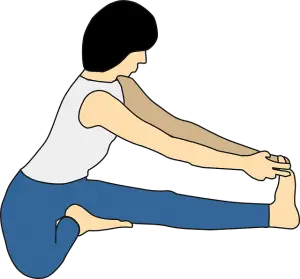
- Flexion is a term used when the angle between body parts decreases. For example, when you are pulling your foot back toward your hip the angle of the knee will become more acute.
- Extension is a term that refers to how much you can extend your leg outward, increasing the angle until it is fully extended with no bend. When you sit on the floor with your legs straight out in front of you and no gap between you and the floor, then your leg is fully extended.
In simple terms, range of motion is just another way of describing how far you can bend and extend your knee.
First Month - The Most Crucial Time for Recovery
After having a total knee replacement, regaining your range of motion is one of your top priorities. The first 2 – 4 weeks after you have surgery are the most crucial to your healing and gaining your range of motion back.
When you come out of surgery, you are going to be experiencing pain and a great deal of swelling. Chances are you are not going to want to dive straight into physical therapy, but you need to fight the urge to lay down and quit.
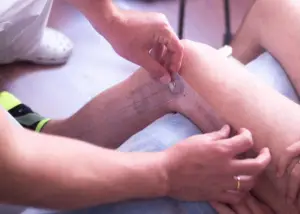
Range of motion is crucial for daily life. To give you a better idea of what you’ll need to get back to normal, here are the degrees of flexion needed to perform some everyday tasks:
- Walking – 65°
- Picking an object off the ground – 70°
- Climbing stairs – 85°
- Getting up from a sitting position – 95°
- Bending to tie shoelaces – 105°
- Squat or sit cross-legged – 115° or greater
Basic Range of Motion Timeline for Recovery
While everyone’s timeline differs a bit, here’s a general timeline for where you should be regarding your range of motion.
When your leg is fully extended (Full flexion) it will measure 0°. When you pull your foot back toward your buttock the maximum flexion that can be achieved in a healthy non-surgical knee is around 140°; however, even people in the best shape have a difficult time reaching 135°. If you can get your flexion to 125° then you are doing great! Keep up the hard work.
0 – 2 Weeks
Within the first 2 weeks, you should be at or around 65°-90° flexion.
2 – 6 Weeks
By the end of the 2-week mark, you should be getting around 90° of flexion. By 6-weeks out you should be approaching the 120° mark.
12 Weeks +
Once you reach the 12-week point you should be able to do most routine tasks and care for yourself without much assistance. Don’t be discouraged if you are not where you want to be at this point. Just keep working. A positive mindset will help more than anything.
Knee Range of Motion Exercises
ROM Exercises that Help the Most
The following exercises are the most common and effective for regaining your range of motion. Stick to a schedule and be diligent in your exercises to gain the most results.
- Quad Sets with a towel under the Heel
- Heel Slides
- Seated Long Arc Quads
- Seated Knee Extension
- Seated Knee Flexion
- Short Arc Quads (lying position)
A Positive Attitude Accelerates Recovery
Think about the children’s story about the little engine that could; no matter how hard the task, don’t give up. The thing that will help your recovery the most is having a positive, “can-do” attitude. Hard work and perseverance will make all the difference between a quick recovery or a long-drawn-out ordeal.
Sources:
(https://www.merckmanuals.com/professional/special-subjects/rehabilitation/physical-therapy-pt),
(https://www.benefits.va.gov/PREDISCHARGE/DOCS/disexm34.pdf),
Other Great Rehab Related Articles
How to Stay Active After Cervical Fractures: Expert Tips and Advice
Dealing with Painful Stairs After Ankle Replacement Surgery
Walking After a Total Ankle Replacement: Tips for a Successful Recovery
Exercises While Non-Weight Bearing After Ankle Replacement: Elevation, AROM, Leg Raises, and More
Ankle Pain with Stairs: Causes and Home Treatment Options
5 Common Mistakes You’re Making After an Ankle Sprain
Disclaimer: The information provided in this post is for educational purposes only. This is not a substitute for a medical appointment. Please refer to your physician before starting any exercise program.
